 Apollinaire et ses amis, Marie Laurencin, 1907
Apollinaire et ses amis, Marie Laurencin, 1907
Marie Laurencin:
[Taking a gulp of her wine.]
I want to know about her shaggy
hair. Did her mother put ribbons
there? I want to touch her long
black locks. What freedom
made her mock
clothing so? Guillaume, Cheri,
hand me my lorgnette.
[Guillaume pulls from his pocket a folded lorgnette, opens out the handle and offers it to Marie. She gives him her brush in exchange for the glasses.]
Gertrude, you magnifying glass, come
link arms that we may study this portrait
together.
[She staggers over to Gertrude and hooks her arm into Gertrude’s. Alice frowns and then takes Marie back to Guillaume.]
Monsieur Rousseau, I want to know
about her shaggy hair.
Pablo Picasso:
Yes, the way it snakes
to her voluptuous
knees.
[Pablo runs his hand down Fernande’s leg as he eyes Marie. Fernande, glaring first at Pablo and then Marie, goes to the table for a goblet of wine.]
Guillaume Apollinaire:
[oblivious to everyone except Marie:]
And her thighs,
her calves!
Who or what
does she
love?
Henri Rousseau:
She loves her mother.
Guillaume:
[Suddenly pulled to his senses.]
You’ve got to be kidding.
Guess her mother doesn’t sit
at the gaming tables all day.
[He takes a goblet and drinks.]
Henri:
[More earnestly:]
She loves her mother.
Gertrude Stein:
Just like me,
having the buttons
to prove it.
Leo Stein:
Buttons?
Leave Mother out of this!
It’s Alice, not Mother,
not me.
Marie
What about
the platypus?
Isn’t the pink-winged
bird a bit like us?
[Drinks and then throws down her goblet.]
Everyone
What?
What?
What is a genius?
Pablo
Henri, come sit
on the throne
I’ve made for you.
[Pablo escorts Henri to the throne.]
The legs are uneven,
the arms a bit cracked.
Marie
Yes, do, Monsieur Rousseau,
before the candle wax melts
and ruins the floor for dance.
[Marie holds her arms out and spins, avoiding the broken goblet.]
Gertrude Stein Invents a Jump Early On
First Act
Opera composed by William C. Banfield to a libretto by the poet Karren LaLonde Alenier
On March 10, 2002 the music from act II of Gertrude Stein Invents A Jump Early On was workshopped presented under the sponsorship of the National Opera Association and Opera Index at the Manhattan School of Music in New York City in a program entitled New American Opera Previews: From Page to Stage.
Gertrude Stein Invents A Jump Early On–three portraits of Gertrude Stein’s life and work from 1908-1944 as researched and embellished by poet-librettist Karren Alenier. Piano and voice score are completed. Music might be characterized as a fusion of new classical music and jazz. Presented by Encompass New Opera Theatre and Nancy Rhodes, artistic director.
 Rousseau’s grave with poem by Apollinaire
Rousseau’s grave with poem by Apollinaire











